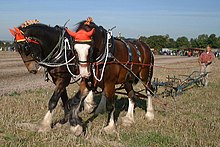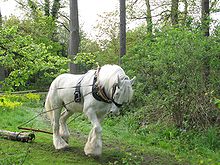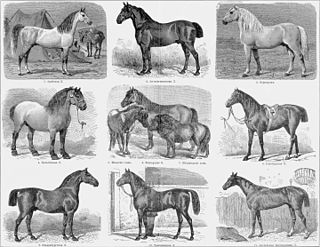
A horse breed is a selectively bred population of domesticated horses, often with pedigrees recorded in a breed registry. However, the term is sometimes used in a broader sense to define landrace animals of a common phenotype located within a limited geographic region, or even feral "breeds" that are naturally selected. Depending on definition, hundreds of "breeds" exist today, developed for many different uses. Horse breeds are loosely divided into three categories based on general temperament: spirited "hot bloods" with speed and endurance; "cold bloods," such as draft horses and some ponies, suitable for slow, heavy work; and "warmbloods," developed from crosses between hot bloods and cold bloods, often focusing on creating breeds for specific riding purposes, particularly in Europe.

A draft horse (US) or draught horse (UK), also known as dray horse, carthorse, work horse or heavy horse, is a large horse bred to be a working animal hauling freight and doing heavy agricultural tasks such as plowing. There are a number of breeds, with varying characteristics, but all share common traits of strength, patience, and a docile temperament.

The Friesian is a horse breed originating in Friesland in north Netherlands. The breed nearly became extinct on more than one occasion. It is classified as a light draught horse, and the modern day Friesian horse is used for riding and driving. The Friesian horse is most known for its all-black coat colour, its long flowing mane and tail, feathering on its legs, a high head carriage, and high stepping action.

The Clydesdale is a Scottish breed of draught horse. It takes its name from Clydesdale, a region of Scotland centred on the River Clyde.

The Percheron is a breed of draft horse that originated in the Huisne river valley in western France, part of the former Perche province, from which the breed takes its name. Usually gray or black in color, Percherons are well-muscled, and known for their intelligence and willingness to work. Although their exact origins are unknown, the ancestors of the breed were present in the valley by the 17th century. They are believed to descend from war horses. Over time, they began to be used for pulling stagecoaches; and later, for agriculture and hauling heavy goods. In the late 18th and early 19th centuries, Arabian blood was added to the breed. Exports of Percherons from France rose exponentially in the late 19th century, and the first purely Percheron stud book was created in France in 1893.
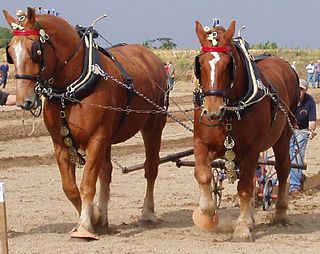
The Suffolk Horse, also historically known as the Suffolk Punch or Suffolk Sorrel, is an English breed of draught horse. The first part of the name is from the county of Suffolk in East Anglia, and the word "Punch" is an old English word for a short stout person. It is a heavy draught horse which is always chestnut in colour, traditionally spelled "chesnut". Suffolk Punches are known as good doers, and tend to have energetic gaits.
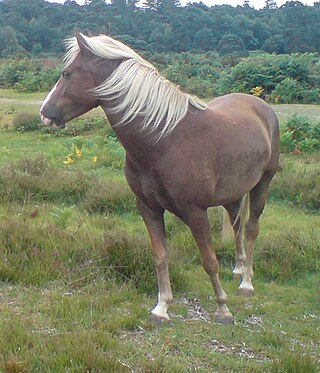
The New Forest pony is one of the recognised mountain and moorland or native pony breeds of the British Isles. Height varies from around 12 to 14.2 hands ; ponies of all heights should be strong, workmanlike, and of a good riding type. They are valued for hardiness, strength, and sure-footedness.

The Gypsy Cob, also known as the Traditional Gypsy Cob, Irish Cob, Romani Cob, Gypsy Horse, or Gypsy Vanner, is a breed of domestic horse from the British Isles. It is a small, solidly-built horse of cob conformation and is usually piebald. It is associated with Irish Travellers and English Romanichal Travellers. There was no stud-book or breed registry for these horses until 1996, but as breeders developed standards and recorded pedigrees, there are now organizations that register qualifying horses..

The Cleveland Bay is a breed of horse that originated in England during the 17th century, named after its colouring and the Cleveland district of Yorkshire. It is a well-muscled horse, with legs that are strong but short in relation to the body. The horses are always bay in colour, although a few light hairs in the mane and tail are characteristic of some breed lines. It is the oldest established horse breed in England. The ancestors of the breed were developed during the Middle Ages for use as pack horses, when they gained their nickname of "Chapman Horses". These pack horses were cross-bred with Andalusian and Barb blood, and later with Arabians and Thoroughbreds, to create the Cleveland Bay of today. Over the years, the breed became lighter in frame as they were employed more as carriage and riding horses. The popularity of the Cleveland Bay has greatly fluctuated since it was first imported to the United States in the early nineteenth century. Despite serious declines in the population after the Second World War, the breed has experienced a resurgence in popularity since the 1970s, although only around 550 horses existed worldwide as of 2006.

The Dales Pony is a British breed of pony or small horse. It originated in, and is named for, the Dales of Yorkshire in northern England. It is one the nine native mountain and moorland pony breeds of the United Kingdom, and belongs to the broader Celtic group of ponies which extends from Portugal and northern Spain to Scandinavia.

The Exmoor Pony is a British breed of pony or small horse. It is one of the mountain and moorland pony breeds native to the British Isles, and so falls within the larger Celtic group of European ponies. It originates on, and is named for, the Exmoor area of moorland in north-eastern Devon and western Somerset, in south-west England, and is well adapted to the climate conditions and poor grazing of the moor. Some still live there in a near-feral state, but most are in private ownership.
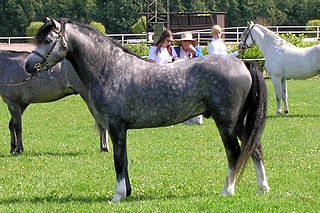
The Welsh Pony and Cob is a group of four closely-related horse breeds including both pony and cob types, which originated in Wales. The four sections within the breed society for the Welsh breeds are primarily distinguished by height, and also by variations in type: the smallest Welsh Mountain Pony ; the slightly taller but refined Welsh Pony of riding type popular as a children's show mount; the small but stocky Welsh Pony of Cob Type, popular for riding and competitive driving; and the tallest, the Welsh Cob, which can be ridden by adults. Welsh ponies and cobs in all sections are known for their good temperament, hardiness, and free-moving gaits.
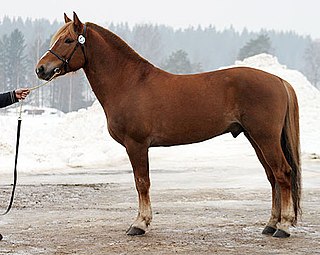
The Finnhorse or Finnish Horse is a horse breed with both riding horse and draught horse influences and characteristics, and is the only breed developed fully in Finland. In English it is sometimes called the Finnish Universal, as the Finns consider the breed capable of fulfilling all of Finland's horse needs, including agricultural and forestry work, harness racing, and riding. In 2007, the breed was declared the official national horse breed of Finland.
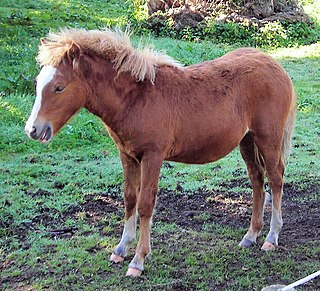
The Kerry Bog Pony is a mountain and moorland breed of pony that originated in Ireland. Possibly descended from the Irish Hobby horse, it originally lived a mainly feral existence in the peat bogs of what is now County Kerry in southwestern Ireland. Local inhabitants used the ponies as pack and cart horses for transporting peat and kelp to the villages. The breed developed physical characteristics including a low weight-to-height ratio and an unusual footfall pattern, which helped it move on soft ground such as peat bogs. The ponies were known for hardiness and an ability to survive in harsh conditions.
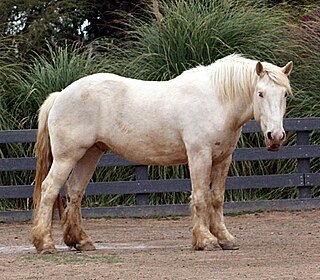
The American Cream Draft is an American breed of draft horse, characterized by the cream or "gold champagne" color of its coat. It was developed in Iowa during the early twentieth century from a cream-colored mare named Old Granny. A breed registry was formed in 1944 but became inactive for several decades when breed numbers dropped due to the mechanization of farming. It was reactivated in 1982 and population numbers have slowly grown since then. It is a rare breed: its conservation status is considered critical by The Livestock Conservancy and the Equus Survival Trust.

The Jutland horse is a draft horse breed originating in Denmark, named after the Jutland Peninsula which forms the western part of the country. Usually chestnut, they are a compact, muscular breed known for their calm and willing temperament. The breed was originally developed for use in agriculture, but today is more often seen in urban settings and at horse shows. Some of the best known members of the breed pull beer wagons for the Carlsberg brewery around Copenhagen, as well as at competitions and for demonstrations. Images from the 9th century show a horse similar to the Jutland being used by Viking raiders in what is now Great Britain. The first written record is from the 12th century, when they were popular as war horses. Some infusion of bloodlines from other breeds occurred in the 18th century, but the modern Jutland type only began about 1850 with the addition of blood from several other breeds, mainly draft horses. A stud book was created in the late 19th century, and the Jutland population grew to a maximum around 15,000 by 1950. Numbers subsequently declined, and as of 2011, only an estimated 1,000 horses remained.
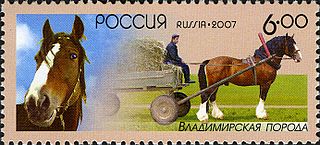
The Vladimir Heavy Draft is a Russian breed of heavy draught horse. It was bred in the early twentieth century in farms and collectives in Ivanovo Oblast and Vladimir Oblast, to the east of Moscow. The most important influence on the development of the breed was from three Clydesdale stallions foaled between 1910 and 1923. The Vladimir was officially recognised in 1946.

The Carolina Marsh Tacky or Marsh Tacky is a critically endangered breed of horse, native to South Carolina. It is a member of the Colonial Spanish group of horse breeds, which also include the Florida Cracker Horse and the Banker horse of North Carolina. It is a small horse, well-adapted for use in the lowland swamps of its native South Carolina. The Marsh Tacky developed from Spanish horses brought to the South Carolina coast by Spanish explorers, settlers and traders as early as the 16th century. The horses were used by the colonists during the American Revolution, and by settlers for farm work, herding cattle and hunting throughout the breed's history.

Mountain and moorland ponies form a group of several breeds of ponies and small horses native to the British Isles. Many of these breeds are derived from semi-feral ponies kept on moorland or heathland, and some of them still live in this way, as well as being kept as fully domesticated horses for riding, driving, and other draught work, or for horse showing.
The Estonian Draft or Eston-Arden is a breed of draft horse developed in Estonia. They were developed from a cross of Estonian Native horses and Swedish Ardennes and officially recognized by the Estonian government in 1953. Population numbers have decreased since the early 1990s and today inbreeding is of significant concern and the breed is considered to be endangered by the Estonian government. Although originally used for heavy draft work, they are now used mainly for small-scale gardening.

